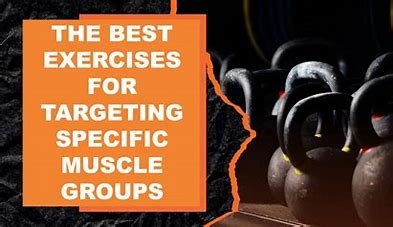Targeting specific muscle groups during exercise is an effective way to focus on strengthening and toning particular areas of the body. By isolating muscles or muscle groups, you can enhance their strength, endurance, and appearance while improving overall body balance and performance.

1. Legs (Quads, Hamstrings, Glutes, Calves)
- Quadriceps (Front of Thigh):
- Exercises: Squats, lunges, leg press, leg extensions.
- Function: Extend the knee and stabilize the leg during movement.
- Tips: Ensure your knees don’t extend beyond your toes in squats or lunges to avoid strain.
- Hamstrings (Back of Thigh):
- Exercises: Deadlifts, leg curls, Romanian deadlifts, glute bridges.
- Function: Flex the knee and extend the hip.
- Tips: Focus on keeping the knees slightly bent during deadlifts to activate the hamstrings properly.
- Glutes (Buttocks):
- Exercises: Squats, lunges, hip thrusts, glute bridges, step-ups.
- Function: Hip extension and stabilizing the pelvis.
- Tips: Squeeze the glutes at the top of the movement (e.g., at the top of a squat or hip thrust) for maximum activation.
- Calves (Lower Legs):
- Exercises: Calf raises (standing or seated), box jumps, jump rope.
- Function: Plantarflexion of the foot (pointing the toes downward).
- Tips: Perform calf raises slowly, focusing on a full range of motion to engage both the gastrocnemius and soleus muscles.
2. Back (Upper and Lower)
- Upper Back (Traps, Rhomboids, Lats):
- Exercises: Lat pulldowns, pull-ups, barbell rows, dumbbell rows, face pulls.
- Function: Pulling movements, scapular retraction, and shoulder stability.
- Tips: Keep your shoulders down and back during rows and pulldowns to engage the upper back muscles effectively.
- Lower Back (Erector Spinae):
- Exercises: Deadlifts, back extensions, hyperextensions, kettlebell swings.
- Function: Spinal extension and core stability.
- Tips: Focus on maintaining a neutral spine during deadlifts to avoid unnecessary strain on the lower back.
3. Chest (Pectorals)
- Exercises: Bench press, push-ups, chest flyes, incline press, cable crossovers.
- Function: Horizontal adduction (bringing the arms toward the midline of the body).
- Tips: Keep your shoulders back and chest open during chest exercises to engage the pectorals properly and avoid shoulder strain.
4. Shoulders (Deltoids)
- Exercises: Shoulder press, lateral raises, front raises, upright rows, reverse flyes.
- Function: Abduction, flexion, and extension of the shoulder joint.
- Tips: Focus on form, especially in overhead presses, to avoid stressing the shoulder joints. Don’t let your elbows go too high during lateral raises.
- Front Deltoids: Targeted with exercises like overhead press and front raises.
- Lateral Deltoids: Targeted with exercises like lateral raises.
- Posterior Deltoids: Targeted with reverse flyes or bent-over lateral raises.
5. Arms (Biceps, Triceps, Forearms)
- Biceps (Front of the Upper Arm):
- Exercises: Bicep curls (dumbbell, barbell, cable), hammer curls, chin-ups.
- Function: Elbow flexion (bending the arm at the elbow).
- Tips: Keep your elbows close to your body during curls to ensure the biceps are doing the majority of the work.
- Triceps (Back of the Upper Arm):
- Exercises: Tricep dips, tricep pushdowns, close-grip bench press, overhead tricep extensions.
- Function: Elbow extension (straightening the arm at the elbow).
- Tips: Focus on full extension at the top of tricep movements to maximize muscle engagement.
- Forearms:
- Exercises: Wrist curls, reverse curls, farmer’s walks, grip strength exercises.
- Function: Flexion and extension of the wrist.
- Tips: Use a moderate weight to avoid straining the wrist, and focus on controlled movements.
6. Core (Abdominals, Obliques, Lower Back)
- Abdominals:
- Exercises: Crunches, sit-ups, leg raises, cable crunches, planks.
- Function: Flexion of the spine, stabilizing the torso.
- Tips: Engage the core throughout the movement and avoid pulling on your neck during crunches.
- Obliques (Side Muscles):
- Exercises: Russian twists, side planks, side crunches, woodchoppers.
- Function: Lateral flexion and rotation of the trunk.
- Tips: Maintain controlled movements during rotational exercises to prevent lower back strain.
- Lower Back (Erector Spinae):
- Exercises: Hyperextensions, deadlifts, back extensions.
- Function: Spinal extension and support.
- Tips: Focus on keeping a neutral spine to prevent strain on the lower back.
Sample Full-Body Routine with Specific Muscle Focus:
1. Squats (Legs)
2. Bench Press (Chest)
3. Deadlifts (Back)
4. Overhead Shoulder Press (Shoulders)
5. Bicep Curls (Arms)
6. Tricep Dips (Arms)
7. Plank (Core)
8. Calf Raises (Legs)
Tips for Effective Targeting:
- Progressive Overload: Gradually increase the weight or repetitions to continuously challenge the muscles and promote growth.
- Rest Between Sets: For strength training, rest for 60-90 seconds between sets; for muscular endurance, rest for 30-60 seconds.
- Form is Key: Always prioritize proper form to effectively target muscles and avoid injury.
